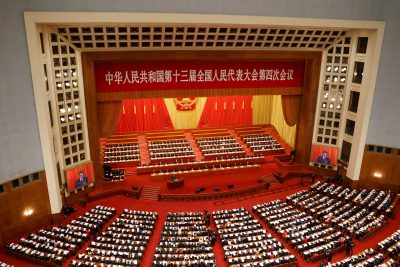Trade
China’s bold economic plans and modest targets

Author: Bert Hofman, NUS East Asian Institute
The annual gathering of China’s National People’s Congress (NPC) took place in March, at the usual time this year. Premier Li Keqiang’s speech and government documents presented showed confidence about past achievements. China’s management of the pandemic and its standing as the only major economy to achieve positive GDP growth in 2020, at 2.3 per cent, were high on the list.
Despite the cheer, the indicative growth target for 2021 was only a modest ‘more than 6 per cent’. This target would not require much growth until the end of 2021 because of the sharp drop in GDP in early 2020. Li Keqiang argued the target is not low and that this year’s focus is to consolidate China’s economic recovery. Setting hugely different growth targets year to year would only ‘disturb’ market expectations, he said.
GDP growth itself was de-emphasised in the 14th Five Year Plan (FYP). Unlike the past, no target for GDP growth over this plan period was presented. Instead, the plan announced a yearly target would be crafted annually ‘in line with the situation’.
Macroeconomic policy for 2021 is set for consolidation. The fiscal deficit as a share of GDP will aim some 3.6 percentage points below that of the 2020 budget, declining from a budgeted deficit of 11.4 per cent of GDP to a projected 7.8 per cent of GDP. The cut in deficit is less steep compared to the outcome of 2020, estimated to have been a deficit of 9 per cent of GDP because last year’s budget was underspent.
The headline number in the budget speech suggests a more modest consolidation, from 3.6 per cent of GDP in 2020 to 3.2 per cent this year. But this number has little to do with the government’s overall fiscal stance. The convoluted budget structure — with four separate budgets — does not help in communicating policy messages.
Li Keqiang also announced monetary policy that keeps aggregate financing in line with nominal GDP growth — in contrast to last year when such growth was to be ‘significantly above’ levels seen previously. Monetary policy will be less expansionary and China’s total debt-to-GDP ratio is projected to move sideways after rising by almost 25 percentage points in 2020.
The 14th FYP — discussed and approved at the NPC — centres around the ‘new development concept’ of dual circulation. President Xi Jinping first presented this idea in a politburo meeting in May 2020. It’s still evolving and opinions differ on implications.
Dual circulation, according to Vice Premier Liu He, emphasises ‘domestic circulation’ by increasing domestic demand, reinforcing domestic supply chains and promoting indigenous innovation, while still seeking further opening up and supply-side reforms. This has already been happening over the past decade.
Tensions with the United States and the post-COVID-19 global economic outlook have increased the perceived need to move towards a dual circulation approach. It can be considered a risk management strategy in case the external environment deteriorates further. The 14th FYP also included targets on food and energy security. ‘We will give priority to domestic circulation’, said Li Keqiang in his government work report. A concern is that dual circulation in the hands of local officials across China may simply become import substitution.
A critical link in the strategy is consumer demand. China’s high savings fuelled a strong investment rate, but intermediation through the banking system has been piling up debt. High investment also came with inefficiency and waste. Heavier reliance on consumption (and lower savings) is key then, but the 14th FYP offers little to address this. Pension and social welfare reforms, better health insurance and more equal development, as announced, could help but are also hard to do.
As part of the strategy, China announced its intentions to rely more on ‘indigenous innovation’ and aims for foundational technology breakthroughs, an area currently more dependent on foreign knowledge. It is in technology that Chinese companies were most vulnerable to actions taken by the US government under the Trump administration — measures yet to be reversed by the Biden team.
The 14th FYP makes an effort to reduce technological dependence. While the target on increases in research and development spending is modest, at 7 per cent growth, the plans are not. More details should follow in the forthcoming Medium and Long-Term Plan for Science and Technology 2021–35, but the 14th FYP is filled with initiatives and…
Trade
Self-Reliance and Openness: Core Principles of China’s Third Plenary Session

The Third Plenum communique from the CCP indicates a prioritization of stability and compromise in response to China’s economic challenges. It highlights the concept of Chinese-style modernization and establishes political guidelines for balancing regulation and market forces.
The CCP’s Third Plenum communique signals a focus on stability and compromise in the face of China’s economic challenges. It emphasises Chinese-style modernisation and sets political directions for balancing regulation and market forces. While not as groundbreaking as previous plenums, it acknowledges the importance of market mechanisms and technological self-reliance, aiming to address issues like high youth unemployment and private sector uncertainty. The communique seeks to navigate the complexities of global competition and domestic innovation, potentially reshaping global supply chains and trade dynamics. Overall, it presents a pragmatic blueprint for China’s economic future.
Source : Self-reliance and openness central pillars of China’s Third Plenum | East Asia Forum
Trade
Trade Prevails Over Political Persuasions in China-Germany Relations

China and Germany maintain a strong bilateral relationship, rooted in economic cooperation despite ideological differences. Recent visits and agreements focus on expanding trade and addressing mutual concerns, navigating challenges while nurturing ties.
Evolving Bilateral Ties
China and Germany share a strong bilateral relationship, rooted in history since 1972. This connection has seen moments of cooperation intertwined with periods of tension. German Chancellor Olaf Scholz’s April 2024 visit underscores Germany’s commitment to fostering this partnership, reflecting a mutual interest in maintaining economic ties despite ideological differences.
Economic Pragmatism
As the second and third largest global economies, China and Germany’s economic interdependence is crucial. Germany emerged as China’s primary trading partner in 2023, with trade values reaching €254.4 billion (US$280 billion). In response to global scrutiny, Germany has taken a balanced approach, emphasizing economic stability over political discord. This was evident during Scholz’s prior visit in November 2022, where his diplomatic tone contrasted with broader EU sentiments.
Facing Challenges Together
Despite increasing public skepticism in Germany regarding China’s global influence and human rights issues, both nations continue to seek common ground. Their October 2023 Joint Statement highlights intentions to pursue cooperation in areas like carbon neutrality and open markets. To navigate these complex terrains, Germany can utilize its institutional frameworks to enhance dialogue, while also considering supply chain diversification to reduce dependency on China. The intertwining nature of their economies suggests that, despite challenges, both countries will continue to prioritize their substantial trade relations.
Source : Trade trumps political persuasions in China–Germany relations
Trade
Fixing fragmentation in the settlement of international trade disputes

Fragmentation in global trade due to the lack of development in multilateral trade rules at the WTO has led to an increase in FTAs. The Appellate Body impasse has further exacerbated fragmentation, requiring a multilateral approach for reform.
Fragmentation in Global Trade
Fragmentation in global trade is not new. With the slow development of multilateral trade rules at the World Trade Organization (WTO), governments have turned to free trade agreements (FTAs). As of 2023, almost 600 bilateral and regional trade agreements have been notified to the WTO, leading to growing fragmentation in trade rules, business activities, and international relations. But until recently, trade dispute settlements have predominantly remained within the WTO.
Challenges with WTO Dispute Settlement
The demise of the Appellate Body increased fragmentation in both the interpretation and enforcement of trade law. A small number of WTO Members created the Multi-Party Interim Appeal Arbitration Arrangement (MPIA) as a temporary solution, but in its current form, it cannot properly address fragmentation. Since its creation in 2020, the MPIA has only attracted 26 parties, and its rulings have not been consistent with previous decisions made by the Appellate Body, rendering WTO case law increasingly fragmented.
The Path Forward for Global Trade
Maintaining the integrity and predictability of the global trading system while reducing fragmentation requires restoring the WTO’s authority. At the 12th WTO Ministerial Conference in 2022, governments agreed to re-establish a functional dispute settlement system by 2024. Reaching a consensus will be difficult, and negotiations will take time. A critical mass-based, open plurilateral approach provides a viable alternative way to reform the appellate mechanism, as WTO Members are committed to reforming the dispute settlement system.
Source : Fixing fragmentation in the settlement of international trade disputes






